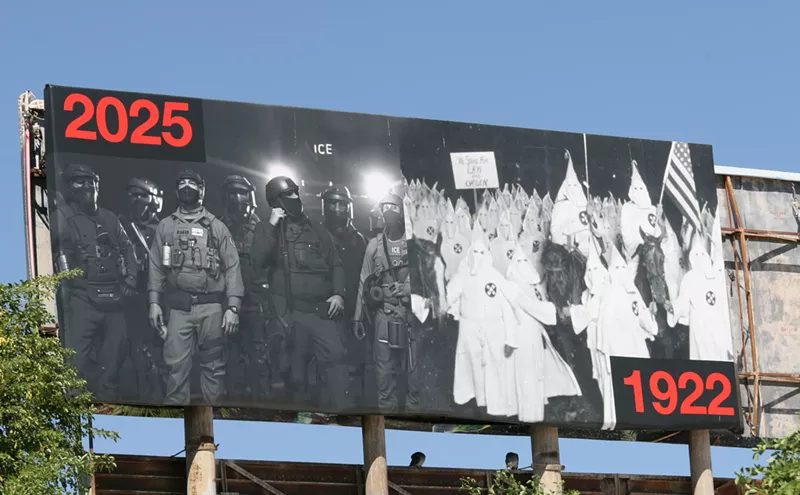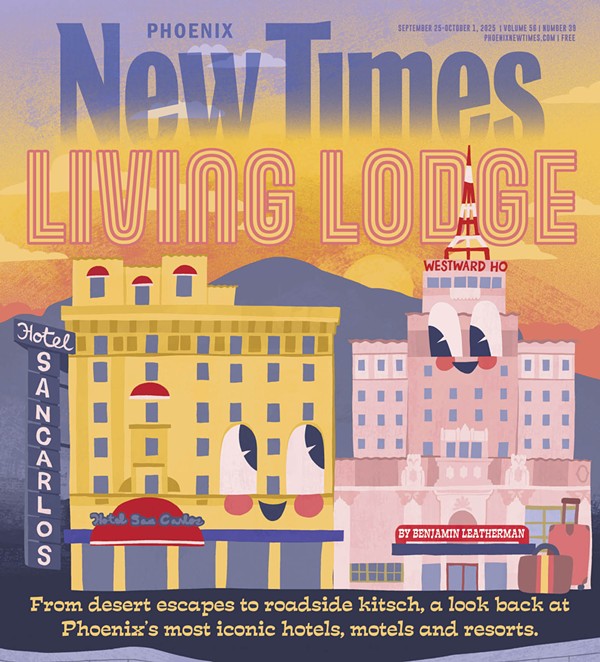It's dark.
The walls are black, the carpeting is black, and even the beanbags offered as seating are black. This dark environment pulls you in as you pass by. It's hard to ignore the images on the screens and the sounds of revving engines and children screaming.
This is the opening scene to "Shifting Sands: Recent Videos from the Middle East" at the ASU Art Museum. The exhibition presents the film and video works of four international artists in their quest to show the changing cultural, political, and geographical environments across the Middle Eastern landscape.
See also: Phoenix Sky Harbor Artwork: A Viewing Guide
The exhibition features the work of Lida Abdul (Afghanistan), Yael Bartana (Germany/Israel), Emily Jacir (Palestine/Italy), and Isabel Rocamora (Spain, U.K.). Kerry Doyle, director of the Stanlee and Gerald Rubin Center for the Visual Arts, described the exhibition in a release from the ASU Art Museum. "'Shifting Sands' not only gives audiences exposure to excellent contemporary art being produced in and about the Middle East, but also serves as a dynamic catalyst for dialogue about culture, politics and current events in the region," she said.
On the first floor of the museum, visitors find the darkened rooms and dim lighting serving as the first half of the exhibition. This striking sensory experience is juxtaposed with the stark white walls that offer the background to the second half, located on the second floor of the museum.
It is strange to have an exhibition of this magnitude split into two disconnected pieces, but it is important to note that several of the rooms were constructed to the artists' specifications. While the experience may suffer a bit from the disruption of a staircase, the loyalty curators showed to the wishes of the exhibiting artists is something to be praised.
And each message still maintains its artistic integrity.
The exhibition consists of several video installations running an average of five to six minutes each. They address different aspects of the cultural climate dominating various parts of Middle Eastern countries during the early 2000s.
Yet, they all seem to have two common threads: futility and an unwillingness to give up. Several of the videos, including Bartana's Kings of the Hill and Abdul's What We Saw Upon Awakening, portray people attempting to complete incredibly daunting and unrealistic tasks. In Kings of the Hill, men in large off-road trucks attempt to drive out of deep ditches and valleys. They struggle through the recreational sport, attempting to conquer the steep slopes while also trying to maintain traction and control over their vehicle.
Abdul's What We Saw Upon Awakening carries this similar sense of hard work with ultimate defeat. Several similarly dressed men pull on ropes attached to a sturdy stone building, attempting to tear down the structure. Yet they pull in an erratic, disconnected way. Both videos portray the need to conquer and create change, but end with a sense of defeat and the inability to overcome obstacles. The pieces are foreboding with palpable tension and struggle.
Desperation makes another appearance in Rocamora's Horizon of Exile. This piece, shown on two side-by-side screens, combines contemporary dance and film into an emotional story about exile and abandonment. Two dancers dressed in severe black clothing native to the Middle East, confront both the viewer and the surrounding desert landscape with a sense of mourning. Their movements are strained, as if they are desperately grasping for something they cannot reach. Several images of one dancer focus on her face and the tears welling and falling as she confronts the camera with a straightforward call for help and understanding.
Each video is a moving, emotional, and sensory experience. Each artist utilizes slow motion to evoke an even stronger sense of distress while simultaneously highlighting the moment when the message of the video becomes clear. With these videos the artists call on the viewers to recognize realities they may not be aware of.
While the videos were taken and constructed in the early 2000s, they are easily relatable to current events and images that confront us through various media every day. Not only is "Shifting Sands" a commentary on the way various landscapes change in the Middle East, but it is also about the timelessness of militarization and conflict.
Jacir's Crossing Surda (a record of going to and from work) is the most potent example of the widespread relatable nature these videos have. Jacir, who worked at Birzeit University during this time, was used to crossing the border between Israel and Palestine each day to get to work. When the Ramallah Birzeit Road was disrupted by an Israeli-manned checkpoint, Jacir was forced into an extremely militarized environment every day. She decided to record her walk to work, using a hidden camera in her purse, to show the nature of this environment.
Not only does the video, shaky and low to the ground, give us a sense of the reality behind military checkpoints, it also harkens back to the reality of the military checkpoints currently in operation on U.S. soil, namely at the U.S.-Mexico border.
"Shifting Sands" reigns in importance for being an entirely female-run exhibition. In a culture where women are stereotypically silenced for their opinions, "Shifting Sands" presents the views and realities of what it means and what compromises must be made for a woman to exist in these environments.
It is also important for bringing together artists of different, and often conflicting, backgrounds to present a necessary show of realities and what they mean across different cultural landscapes. During the current and long-standing conflict between Palestine and Israel, two artists combine their backgrounds and talents to create a dialogue to potentially help alleviate the situation.
Despite the contemporary style of the exhibition, the moving messages these four artists present to viewers is a shocking but necessary revelation. Viewers gain insight into a culture far from their own, while recognizing the need for change both at home and abroad.
"Shifting Sands" is on display at the ASU Art Museum through Saturday, November 29. Admission is always free. For more information, visit asuartmuseum.asu.edu.










